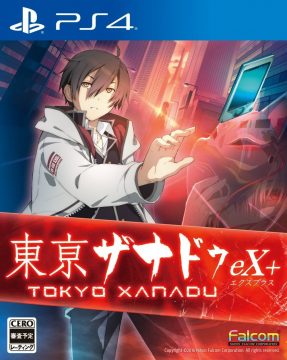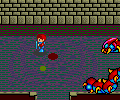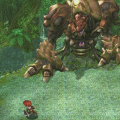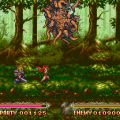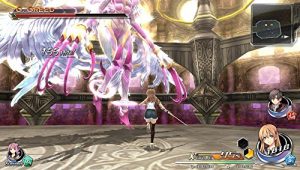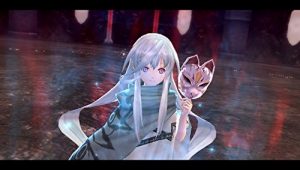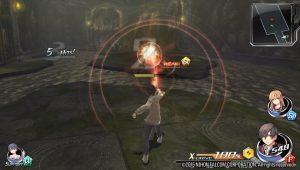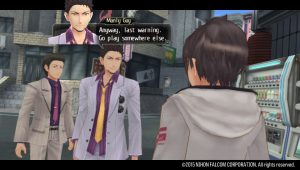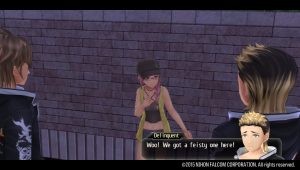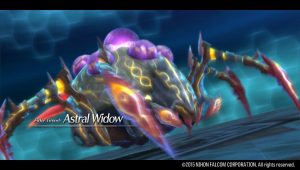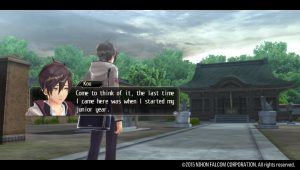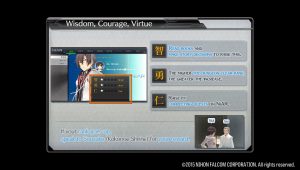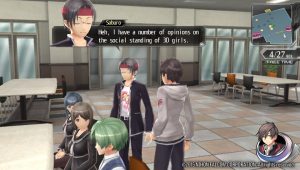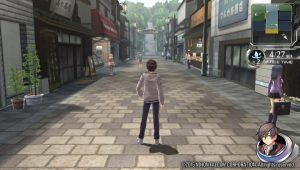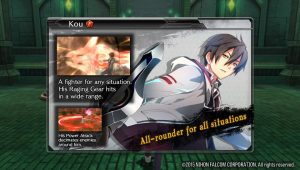The first thing to address about Tokyo Xanadu is the title. The game was published in Japan in 2015, thirty years after the release of Falcom’s PC title Xanadu, and was named as such as a tribute. The company did the same thing on Xanadu’s twentieth anniversary with the PC title Xanadu Next. While Xanadu Next is a modern rendition of classic computer role-playing games, Tokyo Xanadu is not – in fact, outside of the name, there’s barely any relationship at all. It’s actually more of an action-based offshoot of Falcom’s Trails/Kiseki RPG series, particularly in the Cold Steel entries, though set in modern day.
Ironically, the game doesn’t actually take place in the main part of Tokyo either, but rather a similar (fictional) area in its outskirts called Morimiya City. (This is based off Tachikawa City, where Falcom’s offices are located). Ten years prior to the game’s beginning, a series of earthquakes had devastated the area, requiring massive rebuilding. The city has since recovered, but mysterious portals have begun popping up around the city, leading to an alternate dimension, linked by portrals called Eclipses. The protagonist, a high school student named Kou, is made aware of the Eclipse’s existence when he attempts to save his classmate Asuka from a group of thugs. He then becomes aware of the groups that seek to investigate the Eclipse, who both harvest its resources and protect humans from the monsters, known as Greeds, who dwell within.
Main Characters
Kou Tokisaka
The hero of the game, who gets drawn into the fight against the Eclipse after an encounter with his classmate Asuka. Cold and aloof, but courageous and caring. His family is away overseas so he lives on his own and supports himself. His whip-sword is similar to Ragna’s weapon from Falcom’s Zwei II.
Asuka Hiiragi
A teenager who belongs to a group called Nemesis, one of the organizations focusing on the Eclipse. She’s also a little cold and disinterested in anything that doesn’t focus on her job. Her main weapon is a sword.
Sora Ikushima
A member of the karate group who is inordinately talented at fist-fighting.
Yuuki Shinomiya
A genius programmer who develops the popular “God’s App” that takes the school by storm. He’s a bit of a shut-in, as is the stereotypical computer geek. He wields a staff as well as a little satellite that hovers over a shoulder, shooting lasers.
Mitsuki Hokuto
The class president and also a daughter of the Hokuto family conglomerate, which seems to hold inordinate sway over the dealings with the Eclipse. All of her attacks are based on projectiles.
Shio Takahata
The “bad boy”, and founding member of the gang BLAZE, which has some tangles with the local yakuza. His attacks are slow but powerful.
Rion Kugayama
A member of the idol group SPiKA, who spends much of her time traveling around the city while hiding her identity from fans.
Much of the game is drawn from three other popular games: Atlus’ Persona and Falcom’s own Trails of Cold Steel, as well as their other action-RPGs like Ys. The modern day urban fantasy setting is the most obvious inspiration from Persona, especially as each chapter focuses on some kind of problem involving Kou’s classmates, causing more of them to also become aware of the Eclipse and then join your team. Each chapter also begins with a day at school, along with some “free time”, where you can explore the city, purchase stuff at the many, many shops, pursue subquests, or engage in one of the other characters (either party members or NPCs) for a short scenario. Even though there is an in-game calendar, the sim portion is pretty light, and it’s all guided by the storyline, so the choices here are pretty limited. There are also three characteristics to keep in mind – Wisdom, Courage, and Virtue – which are strengthened by reading books, getting high ranks in the dungeon crawling sections, and running as many subquests as possible. In order to get the true ending, you need to raise these to a certain cumulative level, giving you incentive to play by the game’s rules.
To be fair, the day-by-day social interaction aspect is also similar to Cold Steel, which also lightly cribbed from Persona, right down to its obsession with talking to everyone to unlock more subquests. But otherwise, this looks and feels almost exactly like those games – the large cast of characters, the bland but likable designs and personalities, the slow-paced direction of the cutscenes, even the look and style of the interface. It even features a similar customization system, where you can tweak your character’s stats and abilities by equipping colored orbs and unlocking new slots on your weapons.
Compared to Persona and Cold Steel, though, the main difference is that this is an action-RPG. A few times in each chapter, you’ll need to hunt through a dungeon, slash up monsters, grab items, and eventually find the exit. You can take three characters at a time into the dungeon, but unlike Ys Seven or Memories of Celceta, where the other party members were automatically controlled via AI, here there’s only one fight in play at a time. Each has their own fighting style as well as an element – you get bonuses for attacking and killing enemies with the matching element, giving you an incentive to mix and match between your compatriots. (Kou gets the ability to equip all of the different elements instead of being limited to a few, giving him some flexibility.) Each character has a handful of moves beyond their regular attacks, including projectile moves and charge moves (both of which are dictated by a regenerating gauge), as well as assorted jumping attacks and the usual super moves.
For a company that established themselves as the master of action-RPGs with the latter-day Ys series, Tokyo Xanadu is actually a little clumsy. Much of this is due to the camera, which is positioned directly behind your character, rather than taking an overhead view. The lock-on doesn’t always keep track of its targets, and boss battles can be troublesome when you can’t interpret what’s going on around you.
Plus, compared to some of the Ys games, your characters attacks are a little slower and can’t be canceled with a dodge maneuver. Enemies will politely flash before attacking but there are often long wind-ups and they have long range, so you often need to play defensively. Once you’ve gotten used to how to evade the enemy types, it’s not a very difficult game at all. Even if you don’t and have trouble dodging enemy attacks, there are so many healing items to purchase and consume that you’ll rarely find yourself in much trouble. The bland dungeon designs also look and feel like they’re randomly designed, with lots of corridors and open rooms, but they actually aren’t.
Fundamentally, running around these dungeons and slashing stuff is still fun, even if there are better action titles out there, but that plays into the bigger problem with Tokyo Xanadu. It isn’t just that it draws so much from other games, but that it doesn’t understand what made those other games so compelling to begin with. Persona isn’t beloved just because it’s a life/dating sim, but also because it presents compelling scenarios that examine the characters’ psychologies and how they fit in modern societies. Tokyo Xanadu’s scenarios are pretty typical high school stuff – friends get jealous, family members get ignored, drug and delinquent problems, etc. – and other things draw too much from other anime/manga media, like the presence of an idol group. There’s even a chapter where heavy fog rolls into town and civilians get drawn into the Eclipse, which gets a little too close to Persona 4’s central premise. Plus, Kou is a boring protagonist, actively disinterested in all of the hobbies and talents of his peers, with his main strengths being his work ethic (he has tons of part time jobs), yet everyone seems to drawn to him anyway. There’s not even much of a dating element, considering Kou doesn’t seem to have much of a romantic interest in anyone, despite the female cast routinely fawning over him. Aside from the characterization and storytelling, it doesn’t even have a fraction of pop art Persona’s style – events are introduced by simple text on black backgrounds before lazily sauntering to the next scene.
This is exactly the way that the Cold Steel games tell their story, and fans of those may be more willing to tolerate its lackadaisical pacing. But those they worked because the series has an extraordinary amount of lore and world-building – you might spend hours and hours with your party members as they talk about what feels like nothing, but eventually their backgrounds and history build up together to create an engrossing whole, one that becomes emotionally compelling once tragedy hits them. But Tokyo Xanadu doesn’t have that established background to build upon – some of the ways that the different organizations interact with the Eclipse are interesting, but otherwise, the sluggish pacing doesn’t have much payoff. It does pick up a bit in the back-third of the game, but there are some unexplained gaps, and while some plot twists work (getting an adult as a playable character among the usual gaggle of anime teens is a nice change), others don’t (like a huge amount of narrative importance placed on an otherwise minor NPC).
It even falls short of Falcom’s traditionally high standards when it comes to soundtracks. The story tracks are pleasant – again, much like Cold Steel – while at least one of the songs recalls a similar style of Persona 4. But the dungeon themes are mostly bland electronica, with the only standouts being the guitar-focused boss battles. There’s an in-game idol band called SPiKA who provides the vocal themes (including the anime-style introduction scenes that open up each chapter) but they’re fairly typical stuff. The English version, published by Aksys, isn’t dubbed and retains its original Japanese voices. The translation quality is okay, but there are noticeable typos and bits of awkwardness here and there – plus Falcom cat mascot Mishy is translated as “Michy” here – though much of this was fixed for the later PS4 and Windows release.
As a tribute to Falcom’s other titles, there are some nice touches – there’s a PC88-style sprite of Adol on the banner of the city’s arcade, and there are minigames featuring superhero anime renditions of Rean and Alisa, the heroes of Cold Steel, as they play whack-a-mole against Falcom’s cat mascot, Mishy. There are arcade cabinets and other games that name-check Gurumin and Vantage Master, as well as dolls like Noh the fairy from Nayuta no Kiseki and Mona the rabbit from Monarch Monarch. One of the books even makes mention of a red-haired adventurer, obviously a reference to Adol from Ys.
Still, all the fan service can’t shake the fact that this is a pretty disappointing title coming from Falcom – rarely bad, but not nearly to the high standards that they usually hold themselves too. It may have been an acceptable substitute during the eight year gap (2008 – 2016) between the fourth and fifth Persona games, but otherwise it’s poor competition. It was developed as a way for Falcom to train the skills of their junior staff, which explains its quality, though it actually sold significantly better than sales expectations, so a sequel is possible.
Tokyo Xanadu was initially released on the Vita, with an updated version called Tokyo Xanadu eX+ released later for the PlayStation 4 and Windows platforms. It makes some technical enhancements, like running at a higher resolution and a smoother, 60 FPS frame rate. It also significantly expands the story by adding a new playable character, White Shroud, who otherwise spent the original game mostly in the shadows. They wield a new element called Light, which is powerful against every other element except Darkness. There are also new side-chapters focusing one some of the party members other than Kou, as well as a new epilogue, plus extra super attacks for the characters. This release is obviously better on many levels, though the Vita version works just fine as a complete experience for those who prefer the portability.


